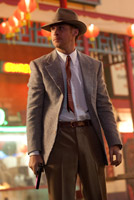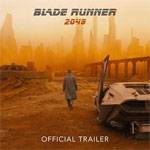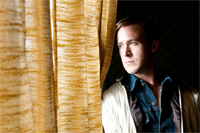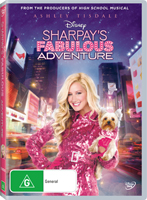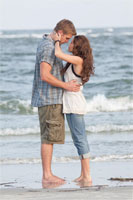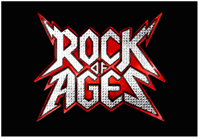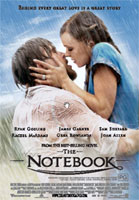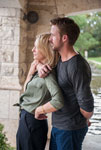Ryan Gosling Blade Runner 2049
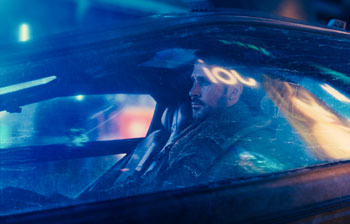
I had your job once…
Cast: Ryan Gosling, Harrison Ford, Robin Wright, Jared Leto, Dave Bautista
Director: Denis Villeneuve
Genre: Sci-Fi, Thriller
Rated: MA
Running Time: 163 minutes
Synopsis: Thirty years after the events of the first film, a new blade runner, LAPD Office K (Ryan Gosling), unearths a long-buried secret that has the potential to plunge what's left of society into chaos. K's discovery leads him on a quest to find Rick Deckard (Harrison Ford), a former LAPD blade runner who has been missing for 30 years.
Watch new footage of Ryan Gosling and Harrison Ford in the first international TV spot for Blade Runner 2049.
Blade Runner 2049
Release Date: October 5th, 2017
Trailer
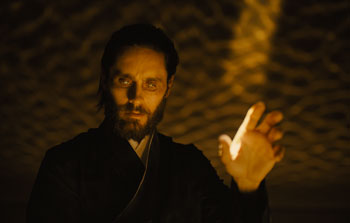 About The Production
About The Production
I had your job once…
'What defines a human being?" That is the question posed by director Denis Villeneuve. And the surprising answers suggested in his new film, 'Blade Runner 2049," challenge people's notions of who we are…and where we are headed.
It's not the first time the value"and values"of humanity have been questioned. Thirty-five years ago, the groundbreaking science fiction film 'Blade Runner" hit theatre screens for the first time. Directed by the legendary Ridley Scott and based on the Philip K. Dick novel Do Androids Dream of Electric Sheep?, the movie thrust audiences into a future unlike anything they had ever experienced that is at once familiar and unfamiliar.
Back then, no one could have imagined how 'Blade Runner" would go on to reverberate through modern culture, pioneering what became an entirely new genre: neo-noir cyberpunk. Today, Scott's visionary masterpiece is heralded as one of the best and most important motion pictures of all time, but its impact has gone beyond filmdom, to television, music, art, fashion, and even university courses.
Now, after more than three decades, 'Blade Runner 2049" returns us to the world that has enthralled generations of fans in a film that is, at once, a long-awaited follow-up and a muchanticipated stand-alone moviegoing experience.
Villeneuve, who counts himself among the first film's devotees, says, 'I vividly remember seeing -Blade Runner' for the first time and being stunned by what I think is amongst the most powerful openings in the history of cinema"flying over the Los Angeles of 2019, and seeing that landscape of oil factories. Ridley Scott presented such a strong image of what could be our future that was at the same time so seductive and so frightening.
'Aesthetically, -Blade Runner' was a revolution," he continues, 'blending two genres that, at first glance, don't go together"science fiction and film noir. It was something never seen before, and it deeply influenced me. It was part of my film education even before I knew I would become a filmmaker."
Ridley Scott says that, even with all of its difficulties, he could never have predicted how iconic one of his earliest major features would come to be. 'You don't think about that when you're in the midst of it, but I knew for sure we had made something really special."
Ryan Gosling, who plays the role of an LAPD blade runner called K, remarks, 'The original film is haunting; it's hard to shake. It asks you to look at your idea of what it means to be human, and it makes you weigh your ability to recognize the hero from the villain. It's a nightmarish vision of the future that's somehow grounded and feels possible, and yet it's presented in this romantic, dreamlike way that sticks with you. Time has proven its specialness."
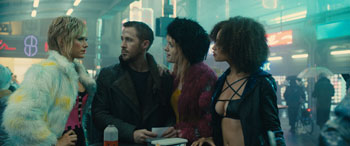 In 'Blade Runner 2049," K is sent on an assignment that, for very different reasons, could have more far-reaching consequences"calling into doubt the divide between people and replicants, between humanity and technology, which could lead to anarchy or even war. But 'Blade Runner" did more than blur the lines between humans and technology. It also broached a range of societal concerns that have grown ever-more prevalent. And with our planet now on the cusp of when that film was set, it seems more revelatory, and more relevant, than ever"foreshadowing issues of urban decay, climate change, genetic engineering, overpopulation, the divides of social and economic strata and more.
In 'Blade Runner 2049," K is sent on an assignment that, for very different reasons, could have more far-reaching consequences"calling into doubt the divide between people and replicants, between humanity and technology, which could lead to anarchy or even war. But 'Blade Runner" did more than blur the lines between humans and technology. It also broached a range of societal concerns that have grown ever-more prevalent. And with our planet now on the cusp of when that film was set, it seems more revelatory, and more relevant, than ever"foreshadowing issues of urban decay, climate change, genetic engineering, overpopulation, the divides of social and economic strata and more. 'It certainly was prescient in many ways," says Ford, who turned Rick Deckard into one of his most indelible onscreen portraits and reprises the role in the sequel. 'I think as technology developed and people began to see some of the issues the film talked about play out in real life, there was even more reason to accept the themes that -Blade Runner' dealt with."
'-Blade Runner' was ahead of its time in so many ways," producer Andrew A. Kosove agrees. With its thought-provoking narrative and signature visual design"which Ridley Scott brilliantly conceived"the movie permeated our culture and changed our perceptions about the relationship between humanity and technology, which, in turn, caused us to question what makes us human. I think that's why it is so revered."
That reverence understandably gave Kosove and his Alcon partner, producer Broderick Johnson, pause when they were approached about the possibility of a 'Blade Runner" follow-up. Johnson confirms, 'We definitely had to think about taking on such an ambitious project, but we both loved the original so we decided we had to go for it."
The idea of filming a new chapter of the 'Blade Runner" story had come to Alcon through producer Bud Yorkin, who had been on the producing team of the earlier film, and his wife, producer Cynthia Sikes Yorkin. She relates, 'It was a dream of Bud's for many years to continue the story and I was so happy to support him in that pursuit. Unfortunately, he passed away before he could see the completion of the film, but it was a wonderful gift for him to know it was going to be done. And Andrew and Broderick were so respectful of Bud and involved us in every aspect of the production from the beginning. They poured their hearts into this project, and I couldn't have asked for better partners to realize this dream of ours."
The initial step forward was to go back to the source. Kosove explains, 'The most important thing was for me and Broderick to go to London to meet with Ridley Scott." Scott, who came on board as an executive producer, affirms, '-Blade Runner' was always meant to be a stand-alone feature, but we knew even then there was more story to tell."
Scott reached out to screenwriter Hampton Fancher, who had co-written the 'Blade Runner" screenplay. Fancher recounts, 'It was serendipity because I had literally just finished a short story set in the -Blade Runner' universe. I read Ridley just the first paragraph and it was obvious what it was. All he said was, -Can you come to London?' So that's how it started." Picking up the story, Scott notes, 'Hampton didn't end up writing a conventional script; he wrote a novella, still with his beautiful style of dialogue. Then we brought in Michael Green to turn it into a screenplay, and it evolved from there."
When the opportunity to work on a new 'Blade Runner" film came to screenwriter Michael Green, 'I couldn't say -yes' loud enough or fast enough," says the self-described avid fan of the first. 'Hampton and Ridley had formed the story DNA of what a new -Blade Runner' film might be, and then I had the incredible opportunity to grow out those elements. There are so many fascinating themes that run through the first film; one of them is about quantity of life. Among the themes we wanted to explore in -Blade Runner 2049' was quality of a life. In both films, there are humans and there are replicants, and though in many respects they behave similarly, they have very different origins, as one is born and one is made. Society places a greater inherent value on humans over replicants because someone born is believed to have a soul. But what is the nature of a soul…and is it uniquely human?"
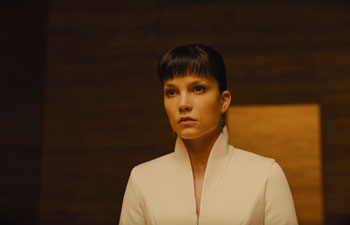 Denis Villeneuve recalls that when he was presented with the completed screenplay, 'I was so moved. The amount of trust Alcon had in me, to put this film in my hands…it was one of the greatest compliments of my career."
Denis Villeneuve recalls that when he was presented with the completed screenplay, 'I was so moved. The amount of trust Alcon had in me, to put this film in my hands…it was one of the greatest compliments of my career." Having worked with Villeneuve on the hit drama 'Prisoners," the producers were fully aware of the skills he could bring to the table. 'Denis is an amazing filmmaker with a total command of everything he wants to accomplish," Johnson states. 'We knew he would be perfect for this film, not only because of his ability to guide the performances, but also to generate tension and atmosphere, which is strong in all his films. That was essential to making -Blade Runner 2049' because the real magic of the film is its tension, its narrative, and its character-based drama. Denis is one of the best at capturing all of that."
Villeneuve reveals he had one caveat before agreeing to helm the film. 'I needed Ridley Scott's blessing. That was my only condition." He needn't have worried; Scott did more than give his blessing. 'He said to me exactly what I needed to hear," notes the director, 'which was that I had total freedom, but if I ever needed him, I could call; he would be available any time. And, in fact, every time I needed him, he was there. I will always be grateful to him."
In conceiving the overall look of the film, Villeneuve wanted to remain faithful to the spirit of the original. He remarks, 'My goal was to honor the film noir aesthetic of the first movie while giving the new film its own identity."
To that end, the filmmakers emphasise that, while 'Blade Runner 2049" can be considered a sequel, it can also very much stand on its own as a singular motion picture. 'Even if you've never seen the first film, you will have no problem understanding the story," Sikes Yorkin attests. 'The way it's written and presented, you can absolutely be very entertained and absorbed in the drama without necessarily knowing everything that came before."
In designing the new movie, the filmmakers had to imagine conditions on the planet three decades hence. Villeneuve clarifies, '-Blade Runner' was set in 2019, and it was prophetic in some ways, but we already know our 2019 will be quite different from that. So we made the decision to create our own 2049"to propel the movie into its foreseeable future. The world of -Blade Runner 2049' is an extension of -Blade Runner'; it is not an extension of reality."
Out of that understanding 'came a lot of decisions about design," he continues. 'We saw in -Blade Runner' that nature was collapsing, so in 30 years' time, the Earth will be even more brutal. We are finding the same kind of oppressive atmosphere that we saw in the first film, but even thicker. The environment will be more toxic; the oceans will be out of control; the weather will be harsher, colder… We are dealing with even more severe climate conditions and that translates to everything from architecture to vehicles to clothing."
To achieve his vision, Villeneuve teamed behind the camera with cinematographer Roger A. Deakins, production designer Dennis Gassner, and costume designer Renée April. 'We shared a strong artistic bond because we were all committed to the same idea of honoring what came before," Villeneuve comments.
That commitment extended to the cast. 'The actors were also very passionate about the project," the director adds, 'and I would say the movie owes a lot to all of them. Ryan Gosling and Harrison Ford especially contributed many great ideas and both were my muses on set." Gosling and Ford have equal praise for their director. 'I had seen Denis' films; I'd admired his films," Ford offers. 'There were interesting meetings...I didn't know what his take on -Blade Runner' was, and it was a while before I began to really understand the depth of his ambition for the film. He's a very quiet and thoughtful and extremely intelligent guy who takes the time necessary to come up with answers for himself. And I found him a great intellectual partner to stumble through the hard questions on the film with."
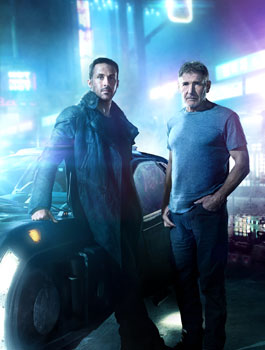 'From my first conversation with Denis, I immediately felt confident," says Ryan Gosling. 'All of his instincts were about grounding the film…making it feel truthful. He had a great respect for the original, but he never seemed to allow it to intimidate him. He used his admiration and turned it into inspiration, and I think, in turn, he inspired all of us to do the same."
'From my first conversation with Denis, I immediately felt confident," says Ryan Gosling. 'All of his instincts were about grounding the film…making it feel truthful. He had a great respect for the original, but he never seemed to allow it to intimidate him. He used his admiration and turned it into inspiration, and I think, in turn, he inspired all of us to do the same." Filming on 'Blade Runner 2049" took place entirely in Hungary, spanning Origo Studios in Budapest; Korda Studios in Etyek; and several other locations around the country.
The filmmaking team made the decision to eschew CGI and green screens as much as possible, in favor of capturing the action in-camera on practical sets. Villeneuve expounds, 'I love to work with real sets, with real objects. It was very important to me to build a world that is tangible around me and the actors so they are living in the setting we've created instead of just trying to imagine it."
For the cast, stepping into the physical environment had the desired result. Gosling affirms, 'It was incredible to have those sets because, as actors, you can really focus on the internal world of your character since the external world has been so fully realized." 'It's like you have this fantastic world around you, but you are always at a human level," Villeneuve states. '-Blade Runner 2049' is a very intimate story told with a lot of scope."
Humans And Replicants
Two of the lead roles in 'Blade Runner 2049" were essentially cast even before there was a script. It goes without saying that no one other than Harrison Ford could be Rick Deckard, but it turns out that the filmmakers also had only one name in mind to play the new blade runner, K: Ryan Gosling.
Fancher tells, 'I was flying to London on my way to meet with Ridley and thinking about a protagonist and thought, -Ryan Gosling; that's the guy.' And I just put that in my back pocket. But then, prescient Ridley"almost the first question he asked was, -Who do you see?' I hadn't even told him my idea yet, but I knew what he meant. I said, -Ryan Gosling,' and he said, -You got it.' We didn't even know what the story was, but I already had an image of the central character and Ryan fit that in every way."
Gosling says his interest in the project was piqued upon learning something was in the works. 'When I heard that Ridley was considering continuing the narrative, I was already invested; I already wanted to know what happened next. And then, given the chance to enter that world and help tell that story…it just felt like an amazing opportunity."
The actor goes on to relate that the world in which we find his character 'has become a much tougher and more isolated place than the one we left 30 years ago. As a result, the blade runner profession has become more complicated. When we first meet K, he is deep in the throes of that isolation and those complications.
'In the beginning of the film," Gosling continues, 'it's a day like any other: K has been sent to -retire' an old-model replicant. But in the process, he unintentionally unearths a mystery that ultimately makes him question everything he thought he knew."
Villeneuve observes, 'K has a very hard life and is a very lonely character. He has the worst job on Earth, but, unexpectedly, out of his latest assignment, comes a dream…a desire so strong that it will blind him. And I thought that was quite a beautiful arc.
'When I read the screenplay," the director adds, 'Ryan Gosling had already been suggested for the role of K, and I said yes immediately. There could be no one else. He is an actor who can express a world of emotion just moving an eyebrow. I needed an actor of extreme intelligence and the kind of strength to go through the darkness. Ryan's passion and his relentless efforts in making sure we nailed every scene deeply moved me because I felt it was as important to him as it was to me to make a great movie together."
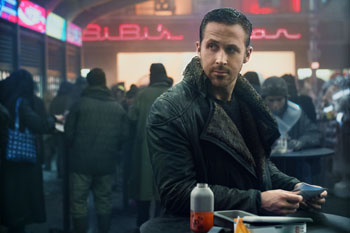 The chorus of voices suggesting Gosling for K also included the actor who starred in 'Blade Runner": Harrison Ford. 'I thought K would be a good part for Ryan and was very enthusiastic about proposing that to the producers. And they said, -Oh yeah, that's what we were thinking, too,' so I was very happy about that. I very much enjoyed working with Ryan in the film. He brings an originality to everything he does and an intelligence, but you don't see the wheels turning. He inhabits a character rather than struggles to create it."
The chorus of voices suggesting Gosling for K also included the actor who starred in 'Blade Runner": Harrison Ford. 'I thought K would be a good part for Ryan and was very enthusiastic about proposing that to the producers. And they said, -Oh yeah, that's what we were thinking, too,' so I was very happy about that. I very much enjoyed working with Ryan in the film. He brings an originality to everything he does and an intelligence, but you don't see the wheels turning. He inhabits a character rather than struggles to create it." Ryan Gosling was no less appreciative of Harrison Ford, noting, 'Harrison Ford is a great filmmaker. There is a reason the majority of his films have become iconic and why so many of them are revisited time after time. He is the constant in all of those equations. There are many ways to play any given scene, but when you work with Harrison Ford, you realise there's only one great way. And he's already figured it out before anyone else."
Ridley Scott recalls that when he initially contacted Harrison Ford about returning to the role of Deckard, 'I think he might have been a little skeptical. Then I sent him the script and he said, -Ridley, this is wonderful. Correction: this is the best script I've ever read.'"
In addition to loving the script, Harrison Ford says, 'It's kind of fun to play a character 30 years later. In a way, I'm used to trying on old clothes," he smiles, 'and happily they still fit, so I didn't have any apprehensions about playing Deckard again."
'It was not possible to make a -Blade Runner' follow-up without Harrison Ford, of course," states Villeneuve. 'For me, it was a huge privilege to work with him because he is someone who is linked with the birth of my love for cinema; I was raised on his movies. First, I had to get rid of the nerves of meeting one of my childhood heroes, but he broke the ice very quickly by being one of the most warm, charming, generous and humble artists I've ever met. And directing him, for me, was like going back to film school because he has so much experience and gives so much thought to the acting process in a way I very rarely encounter. We had the most beautiful discussions about how to approach this character he hasn't seen in so many years."
Within the story, no one has seen Deckard in 30 years. Ford says, 'Deckard has gone through tragic events since the last film. But he was also charged with the protection of certain secrets he had and felt morally obligated to protect those secrets, so he made himself absent. He knew he was being hunted, so he went into hiding in a place no one would expect him to go. A dangerous place. And he's been living a very lonely, singular life."
However, Gosling offers, 'Deckard is a significant person of interest in the case my character is trying to solve. K sets out to find him, seeking to get answers to questions that have become very personal to him."
'K tracks Deckard down," says Ford. 'What transpires between the two of them is extremely compelling. It's a very brave storyline. What I like most is the emotional context, which I think is very valuable."
The clue that puts K on Deckard's trail was uncovered in the archives of the Wallace Corporation. Although most of the records were destroyed in the catastrophic EMP of 2022" known as the Blackout"a few fragmented pieces were salvaged, including one in which Deckard's voice can barely be heard.
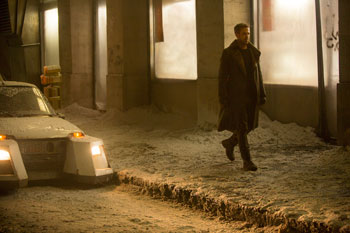 The head of the Wallace Corporation is the enigmatic Niander Wallace, whose soft-spoken manner thinly veils his ruthless ambition. His obsessive quest to create the perfect replicant" totally compliant and unquestioning of human authority"resulted in the creation of the latest model, the Nexus 9. Wallace see replicants as necessary for the survival of humanity…but he can only make so many. Years before, his breakthroughs in genetically modified foods had brought the planet back from the brink of irrevocable global famine. Trading on that debt, he was able to barter for the end of the replicant prohibition and, in the process, gain incalculable wealth…and untold power.
The head of the Wallace Corporation is the enigmatic Niander Wallace, whose soft-spoken manner thinly veils his ruthless ambition. His obsessive quest to create the perfect replicant" totally compliant and unquestioning of human authority"resulted in the creation of the latest model, the Nexus 9. Wallace see replicants as necessary for the survival of humanity…but he can only make so many. Years before, his breakthroughs in genetically modified foods had brought the planet back from the brink of irrevocable global famine. Trading on that debt, he was able to barter for the end of the replicant prohibition and, in the process, gain incalculable wealth…and untold power. Cast in the role of Wallace, Jared Leto remarks, 'I maybe have a different perspective on Niander Wallace than others would. He is the guy who saved the world from starvation, so I don't think his ego is too far out of control for someone who literally saved the planet. He is someone who willed himself to power through really hard work and rigorous study. Wallace is a genius and he's also a bit of a madman, which he'd have to be. He's so fascinating and complex. It was a really seductive role."
Leto reveals that his connection to the 'Blade Runner" universe goes back to 'when I was very young and saw it on VHS. There are films that come along and, for one reason or another, strike a chord. They affect you in some way and change how you see the world. -Blade Runner' was a film that had a big impact on me and has always stuck with me. There was something about it that spoke to me as a kid that I couldn't let go of. So it's always had a special place in my heart and it's something I've looked to for inspiration over the years."
'Niander Wallace is a tough part to play because you have to deal with a lot of difficult dialogue. It required an actor who could embrace those speeches and bring them to life with a strength and poetry. And what can I say? I chose a rock star and he just blew us away," states Villeneuve, who adds that he appreciated Leto's total immersion in every facet of the role. 'I had heard how Jared embodies his character and I wondered what he would do about Wallace, with regard to him being blind. He came in and he was blind…he acted blind."
In researching that aspect of his role, Leto spent time with people who were visually impaired, observing things like how they navigate a specific space or interact in conversation. 'I could feel that Jared was someone who was deeply passionate and very serious about what he was doing," says Villeneuve. 'He was 100 percent committed."
Correspondingly, Leto had nothing but praise for Villeneuve, commenting, 'Denis is a rare artist. What I love about him is that he's eternally fascinated and enthusiastic and curious by nature. He's completely in the moment with the actors and there's a sense of discovery and
excitement around him that's very compelling. I found him to be just an incredible director and I'm truly thankful that I had the chance to do this film with him."
Given his work, it stands to reason that Wallace's right hand would be an elite Nexus 9 replicant. Sylvia Hoeks plays Luv, whose single-minded devotion to Wallace goes far beyond duty. 'He is much more than her boss," she observes. 'What's intriguing about Luv is she was created by Wallace, and if he made her, it means he can break her at any time, so I think some of her drive is based on that fear. The thing she focuses on is being the best, being everything he expects her to be and more. She is willing to do whatever it takes to help him conquer the world and achieve his dreams. It feels to her like the key to happiness…even though she doesn't really know what happiness is."
As preparation for her role, Hoeks notes, 'I wanted to focus on young, powerful, successful women today, as they are in a race to be the best. And they are often judged for what they do, the actions they take, where they live and even what they consume. So in a very different sense, it's like they are made"their image is manufactured in a way"and I thought that was a very interesting approach for this character."
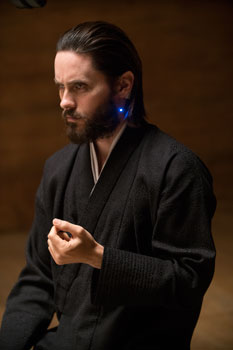 Villeneuve calls Hoeks 'one of the best artists I have ever worked with in my life. She is an actress with a lot of strength and who is not afraid to do some pretty wild things for her role."
Villeneuve calls Hoeks 'one of the best artists I have ever worked with in my life. She is an actress with a lot of strength and who is not afraid to do some pretty wild things for her role." The woman at K's side is Joi, with whom he has more than a romantic relationship. She is his friend, his confidante and his only real support system. Ana de Armas, who plays the role, offers, 'Joi is smart, funny and intuitive, especially where K is concerned. She is also undeniably sexy but she is much more than what you see on the surface. She is actually quite complex."
De Armas enjoyed developing the role with Villeneuve, noting, 'It was interesting to explore my character with him. Her existence in itself was a huge starting point for me, and I had so many questions in my head: Who is she? What is she feeling? What are the rules we have to follow to build on that from one scene to the next? Denis gave me so much freedom to discover all of those things and more as the movie progressed."
'I know Ana has done movies before, but it is rare as a director to have the impression you are witnessing an actress becoming a star," says Villeneuve. 'She has all the qualities"the energy, the emotion, the power and the skills"to capture the very difficult character that is Joi." As the stunning developments in K's investigation take him down an increasingly perilous path, Joi is the only one he knows he can trust completely, and she, in turn, gently guides and encourages him, giving him a perspective no one else could offer.
Not even K's superior is privy to all the details of what he's uncovered in his pursuit of the truth. Robin Wright portrays LAPD Lieutenant Joshi, K's no-nonsense boss, whose orders to the blade runner prove she will do whatever is necessary to maintain order. Wright offers, 'Joshi understands the stakes"she knows that a discovery of this magnitude could, as she puts it, -break the world.' But she's also concerned about K. She is aware something is wrong and senses that he might be holding something back. Nevertheless, she can't let her concerns get in the way of her job."
Villeneuve states, 'Robin Wright is a wonderful actress who established a very commanding authority figure as Lt. Joshi. But it was also important to show that Joshi has a compassionate side, especially in her dealings with K, and Robin was able to convey that in a subtle way that fit the character."
Joshi has ordered K to dispatch an old-model replicant named Sapper Morton, who is seemingly nothing more than an innocuous protein farmer when K shows up in his sparse home. 'He is just trying to exist, man, just trying to live," says Dave Bautista, who was cast in the role. 'When K shows up, Sapper's got a bad feeling right off the bat because, for one, he doesn't get visitors, and, two, he doesn't really like visitors. And he realizes this could be the end for him, which is what he's been trying to avoid…why he's been sticking to himself out on the farm, minding his own business."
In casting the part, the director relates, 'Dave was one of the first names that came to mind for Sapper because he's such a charismatic and strong presence. I needed someone who would be like a giant, but a gentle giant…someone who you have empathy for. That empathy is super important for this character. And the kind of melancholic sadness behind the eyes and vulnerability that Dave brought to Sapper was essential."
There was only one problem: Bautista was considerably younger than the role was conceived. Makeup artist Donald Mowat, whom Villeneuve calls 'a master," was responsible for aging the actor. Villeneuve recalls, 'A lot of people commented, -Oh, I didn't know he was that old.' And I knew it was a success because they were not seeing the makeup; it was just an older Dave Bautista."
K's mission to retire Sapper should have been just another routine assignment. He never imagined his investigation would open the door to a staggering revelation"one that would challenge all of his beliefs.
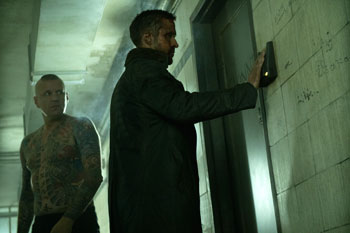 Rounding out the main cast are: Mackenzie Davis as Mariette, a mysterious 'doxie" who takes a particular interest in K; Carla Juri as Dr. Ana Stelline, whose job is integral to the creation and behavior of replicants; and Lennie James as Mister Cotton, who watches over hundreds of abandoned children and who may have answers for K.
Rounding out the main cast are: Mackenzie Davis as Mariette, a mysterious 'doxie" who takes a particular interest in K; Carla Juri as Dr. Ana Stelline, whose job is integral to the creation and behavior of replicants; and Lennie James as Mister Cotton, who watches over hundreds of abandoned children and who may have answers for K. The Shape Of Things To Come
Prior to the start of principal photography on 'Blade Runner 2049," Villeneuve spent several weeks with his longtime cinematographer Roger Deakins drawing storyboards and shaping the visual look of the film. 'So Roger was an integral part of the cinematic language of the film from the start," says the director.
Andrew Kosove shares, 'Roger, who is one of the greatest cinematographers of all time, actually took a year off to prepare for this movie. He has said it involved some of the most complex lighting designs and patterns he's ever done."
Nevertheless, Deakins states, 'It was too exciting an opportunity to miss. Denis and I were not constrained but rather informed by the original, which offered one of the first and most stylized views of an apocalyptic future."
Villeneuve adds, 'One of the biggest challenges was to tie both movies together visually" to have the feeling of walking into a future inspired by the past."
Arguably, the most indelible visual imprint of the first 'Blade Runner" was its dark, wet, oppressive atmosphere, and conditions have not improved in the 30 years since. The director expounds, 'I'm coming from Montreal, so the movie's climate was more informed by bad days in Canada, where it can be bitter cold, so instead of the constant rain, there's also snow and sludge."
Ridley Scott remarks, 'The style is important, and Denis got that nicely with respect to what we did in the first film." The majority of the population, who are not among the super-rich, eke out an existence in cities of soaring buildings that pierce permanently gray skies. Production designer Dennis Gassner recalls, 'The first thing I asked Denis was if he had to put the design into one word"the touchstone for the film"what would it be? And Denis said -Brutal. I want the architecture to be brutal.' And so, we just dove into our research and found images that developed into what I call the -pattern language.'"
'The thing about -Blade Runner 2049' is that everything is designed around survival, from technology to architecture," Villeneuve adds. 'The buildings were designed to resist the weather, so many of them look like bunkers."
Brutal was also the watchword for the costumes, designed by Renée April. 'It's a harsh environment; it's rainy, sometimes it snows," she confirms. 'That was our starting point. For materials, I worked a lot with fake fur and plastic, which was a first for me. I couldn't use leather or wool or any organic materials that would not have existed anymore, so everything was synthetic and manmade. And we also went oversized because it was cold.
'I was so lucky to work with such a great cast who were very into their costumes," the designer continues. 'Ryan Gosling, for example, is very aware of what he can wear, what he likes and what he doesn't. And I must say, he had to like it because K is wearing the same coat for the whole picture."
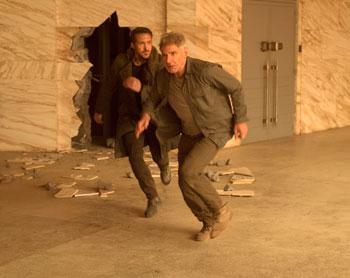 'We all wanted that coat," Sikes Yorkin says. 'Even the women were going crazy over Ryan's coat. Renée is brilliant and came up with such incredible costumes that suited both the characters and the places they inhabit."
'We all wanted that coat," Sikes Yorkin says. 'Even the women were going crazy over Ryan's coat. Renée is brilliant and came up with such incredible costumes that suited both the characters and the places they inhabit." According to April, the costumes for Luv and Joi required two very different approaches. She details, 'For Luv, the silhouette of her clothing is slick and pure. There are no frills, no ruffles and no real colors; everything is beige, white or gray. Joi, on the other hand, is seen in a wide range of costumes in a spectrum of saturated colors and her costumes are more overtly feminine and not as structured."
In designing the wardrobe for Niander Wallace, April says, 'I was inspired by Dennis Gassner's amazing set for Wallace's office, which was huge with very clean lines and a Zen quality about it. So I went with similarly simple lines"almost a uniform or pajamas for someone who doesn't go out and has nothing to prove."
Rick Deckard's clothing fits someone who has been off the grid for decades, 'so what he's wearing was made to look older and a bit threadbare."
Among the most memorable images in the first 'Blade Runner" were the towering electronic billboards with moving advertisements. For the sequel, Broderick Johnson says, 'We took it to the next level, given that its 30 years later. There are 3D holographic ads that have a certain amount of intelligence to them, so, for example, if you're walking down the street, an advertisement might interact with you, which is a terrifying thought," he laughs.
Villeneuve expands, 'Our thinking was that the air in Los Angeles in 2049 is so thick that you can project things into the atmosphere in 3D. So the ads are no longer just huge billboards, they are amongst the population. And that's something that is again an extension of our own reality; it's where we are going.
'As we were planning the movie," Villeneuve continues, 'we met with scientists, doctors, architects, designers, scientists, computer experts…people who told us what they thought the future could be. That informed a lot of the design of the film."
Los Angeles, Circa 2049
Principal photography on 'Blade Runner 2049" was accomplished in Hungary, where the production established a massive footprint"taking over all six soundstages and the backlot at Origo Studios in Budapest; three soundstages at Korda Studios in Etyek; and various other locations around the country.
Executive producer and unit production manager Bill Carraro comments, 'The facilities there are top-notch, as good as you can find anywhere, but what attracted us to Hungary, and Budapest particularly, was the diversity of looks within the city"eastern European architecture mixed in with the brutalist Soviet-era structures."
Villeneuve attests, 'Budapest has a certain aestheticism that impacted the film. We were able to shoot some scenes on the streets of the city because some of the architecture we found there was totally accurate to the spirit of the movie."
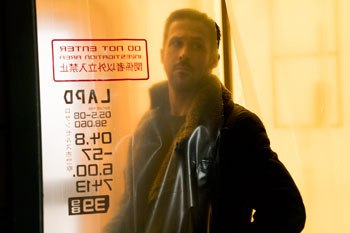 At the Origo and Korda Studios, Dennis Gassner's team built the world of the film almost entirely from the ground up, fulfilling Villeneuve's desire to work on practical sets. The director attests, 'I need real environments because those environments will trigger ideas. Early in the process, the decision was made to construct everything and use very little green screen, and everyone was excited to go in that direction. Of course, there had to be some CGI to extend certain sets, but everything you are seeing in the foreground is real."
At the Origo and Korda Studios, Dennis Gassner's team built the world of the film almost entirely from the ground up, fulfilling Villeneuve's desire to work on practical sets. The director attests, 'I need real environments because those environments will trigger ideas. Early in the process, the decision was made to construct everything and use very little green screen, and everyone was excited to go in that direction. Of course, there had to be some CGI to extend certain sets, but everything you are seeing in the foreground is real." Harrison Ford offers, 'Physical environments are enormously helpful. People behave in a more realistic way when the surroundings are affecting things like the sound of your footsteps. As an actor, I think that helps."
'Blade Runner 2049" opens as K is flying to Sapper Morton's farm in a vehicle that fans of the first film know as a Spinner. Gassner shares, 'The very first thing we designed was K's Spinner, which was intended as an homage to the original, but within the context of the brutalist style Denis wanted."
K's Spinner is a bit boxier and has sharper angles than the one owned by Deckard in 'Blade Runner," but although it is a later model, it is by no means new. Supervising art director Paul Ingis says, 'We tried to craft an interior that feels like the vehicle is 10 to 15 years old. There's a lot of life inside it; there's a lot of age. Everything is worn down and you can see the stains, the marks, the scuffs… It's a set in itself."
There were two Spinners built for K, one of which could actually be driven and had servooperated doors that opened vertically. Equipped with power steering and an electric motor, it could reach groundspeeds up to 50 miles-per-hour, though that wasn't advised on set. The other was designed to fly-by-wire or be mounted on a crane on a gimbal with Gosling inside. Cameras were mounted behind the actor to capture his perspective looking through the windshield, as wipers tried to keep up with the constant rain.
K's Spinner does have a new feature that did not exist in the first film: an intelligent, dronelike object visual effects supervisor John Nelson calls 'the pilot fish. It lives in the back of his Spinner, and when he comes to a stop, it flies up and hovers like a drone. It's like K's digital sidekick that he can tell to -watch the car,' but it can also photograph the area and feed information back."
In addition to K's Spinner, there are other vehicles featured in the film, including a larger multi-seat limousine Spinner and one belonging to Deckard, which is updated from the one he drove in the first film.
Sapper Morton's farm and farmhouse were built on the backlot of Origo Studios. There, the confrontation between K and Sapper was choreographed by stunt coordinator Joel Kramer, who says, 'Ryan put so much thought into everything he did. He'd give up what little free time he had to come train with us, and he picked everything up very quickly."
Kramer took a totally different tack for the battle between K and Luv later in the film. Kramer confirms, 'Even though Luv is a woman, she has as much fighting prowess as K, if not more so. I found a martial arts champion named Chloé Bruce, who can do things with her body that I'd never seen before…moves that didn't even seem human. I showed her demo reel to Denis, Andrew and Broderick and they flipped. We brought Chloé in and had her training alongside Sylvia Hoeks to teach her some of the moves. Sylvia couldn't do them all, obviously" none of us could do what Chloé does"but she really applied herself to it. I was impressed with how well Sylvia did, especially since she'd never really done fights before."
'The action scenes were a big challenge for me," Hoeks acknowledges. 'I trained for six months, which I loved because I was able to do more things with my body. I felt like I transformed into a very strong human being and that helped me to be this character as well. As an actress, it was incredible to have a chance to work on those movements and learn those techniques." The large sets comprising the various offices and archives of the Wallace Corporation took up soundstages at both studios. The clean, minimalist design of Wallace's personal office belies the complexity of the set, with the center surrounded by an interior moat of water and accessible only by an automated stone path. Roger Deakins utilized the rippling pools to bounce and reflect light off of and onto the walls and ceiling to stunning effect.
Inglis offers, 'The lighting was actually more integral to the set than any particular architectural style. Roger was very clear from the start that he wanted the light to be natural, almost like sunlight, which is virtually non-existent outside where the sun is always shrouded in the haze. You'll notice there's not a single window on any of those sets, but within Wallace's world, there is the feeling of an artificial sun as shafts of manufactured sunlight move through it." Standing in his character's domain, Jared Leto says, 'I could feel the energy on that set, and playing someone who is blind, I was able to experience it in a way I otherwise wouldn't have. If you close your eyes, it's incredible what you can tell about a space you're in. And one of the great gifts to me was that in these cathedral-like spaces voices would reverberate off the walls. The sound helped me feel very empowered in my role."
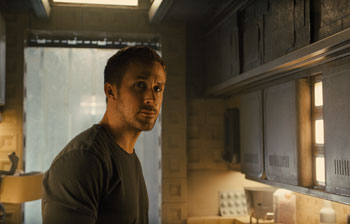 The Wallace Tower stands in stark contrast to the milieu of the less fortunate who subsist outside its walls. One familiar gathering place is Bibi's Bar, a bustling, open air marketplace where throngs of both humans and replicants can purchase everything from food & drink to merchandise to sex. Constructed on a soundstage at Korda, the elaborate set featured rows of touchscreen vending machines with brightly lit displays and various kiosks. Trains passed by overhead and tuk-tuks maneuvered through the more than 300 costumed extras.
The Wallace Tower stands in stark contrast to the milieu of the less fortunate who subsist outside its walls. One familiar gathering place is Bibi's Bar, a bustling, open air marketplace where throngs of both humans and replicants can purchase everything from food & drink to merchandise to sex. Constructed on a soundstage at Korda, the elaborate set featured rows of touchscreen vending machines with brightly lit displays and various kiosks. Trains passed by overhead and tuk-tuks maneuvered through the more than 300 costumed extras. 'Bibi's gave us our first real concentration of color," says Gassner. 'Given the state of nature, it's perpetual winter, so almost everything has a desaturated, gray quality to it, but Bibi's is where we can lift people up with color as Roger does with light."
Other notable sets in the Los Angeles of 2049 included K's small efficiency apartment; the rooftop of his apartment building, where he shares a dance in the rain with Joi; and the police station with Lt. Joshi's office.
Leaving L.A.
Unlike the first movie, 'Blade Runner 2049" takes the story out of the confines of Los Angeles, a change welcomed by Villeneuve. 'That gave me the opportunity to think about what the world would look like outside the vicinity of the city," the director explains. 'It brought a different look to the movie. For instance, as you get farther away, the smog and the atmosphere is less dense so there is more sunlight. I'm not talking about beautiful, bright sunshine"it's still bleak"but more than when you are deep in L.A."
K's investigation takes him south to the San Diego area, where his Spinner is forced to crash land in a vast landfill and scrapyard that stretches as far as the eye can see. The trash mesa, as it was dubbed, was the production's largest set and was built on the backlot at Origo. The immense physical set would later be expanded through the use of miniatures and CGI, allowing it to extend to the horizon and beyond.
Gassner based the design of the trash mesa on giant shipyards where old super tankers and decommissioned Navy ships are taken apart. Amidst the tons of refuse were pieces of rusting metal of varying sizes, some still recognizable as having once been part of a large vessel. For safety reasons, any 'metal" pieces placed anywhere near the actors were fabricated from painted rubber.
Rising out of the mountains of detritus are mammoth-sized, overturned satellite dishes that have been converted into the headquarters of Mister Cotton's salvage business, as well as the grim home of those unfortunate enough to have to live and work there. The interiors were assembled in separate locations: a stage at Origo; the Soviet-era Inota Power Plant, about an hour's drive from Budapest; and a former electronics warehouse in Kistarcsa, Hungary.
Following Rick Deckard's trail eventually leads K out of California to the city of Las Vegas, Nevada, which bears no resemblance to the glittering, neon-lit pleasure capital it was. All its color and light have been reduced to a monochromatic orange/red haze, the result of a catastrophic blast 50 years earlier that left the once vibrant city in ruins and deserted…except for one.
To envision a post-apocalyptic Las Vegas, Villeneuve and Gassner consulted with celebrated futurist and concept artist Syd Mead, who had previously guided Ridley Scott on the City of Angels of 2019. 'We tried to imagine what Las Vegas would look like in 2049," he says. 'And for that, only one man could give me the answer. I went back to the master, Syd Mead, and explained to him my challenge and he brought back these insanely beautiful views of Vegas."
Gassner adds, 'What happened in Vegas and its environment turned it into an extinct place where no one would want to go, which, in turn, made it safe enough for Deckard to hide in plain sight."
In the center of Budapest, the production transformed an unoccupied building that had previously housed Hungary's largest TV station into a Vegas hotel lobby, its former grandeur covered in a layer of red dust. The other hotel/casino sets, including the penthouse, casino and showroom were erected on soundstages at Origo.
In the showroom, echoes of Vegas's glory days come to life in the form of holographic incarnations of the immortal Elvis Presley and Frank Sinatra. Showgirls, costumed by Renée April in feathers and sequins, also dance their way back to the main stage. For Deakins, the performance required an extremely intricate lighting design. He details, 'The show suddenly starts up, but then slowly begins falling apart…kind of glitching…turning it into more of a chaotic light show. I spent weeks mapping out different lighting patterns and then worked with a local company in Budapest to produce a computer previs of the whole thing. We worked from there until I had the lighting pattern I needed to rig."
 Without question, some of the most demanding shooting days were spent in an enormous water tank, built specially by the production for a pivotal action sequence in 'Blade Runner 2049." Special effects supervisor Gerd Nefzer and his team oversaw the construction of the million-gallon tank that ranged from one meter to five meters in depth.
Without question, some of the most demanding shooting days were spent in an enormous water tank, built specially by the production for a pivotal action sequence in 'Blade Runner 2049." Special effects supervisor Gerd Nefzer and his team oversaw the construction of the million-gallon tank that ranged from one meter to five meters in depth. The only problem with the tank was that the water was smooth and the seawall scene called for crashing waves. Nefzer says, 'I looked at different wave machines, but they didn't give us the size we needed, so we had to invent something." Nefzer's crew acquired several commercial-sized propane tanks, which they sealed and affixed on boom arms. They then experimented with synchronized motion, pulling the tanks in and out of the water. As the action was repeated more aggressively, it simulated large, crashing waves.
The SFX team also had to manufacture rigs to enable the transport Spinner, to move when battered by the waves. 'It was very important to Denis that the limousine not sit motionless in the water like a stone. When it gets hit by the water, it should not remain stable. That was a really difficult rig to build," Nefzer admits.
To protect the actors working in the tank, sometimes for hours at a time, large dieselpowered boilers kept the water heated to a relatively comfortable 80 degrees. Against the cold night air, it formed a mist that rose from the pool, adding to the atmospheric tone.
Scale And Scales
Far from Hungary, the cityscapes and landscapes to be seen from overhead, were crafted in miniature by the team at Weta Workshop in New Zealand. However, Villeneuve counters that the term 'miniature" is something of a misnomer. 'Some of those miniatures were gigantic!" he states.
Weta's director of photography, Alex Funke, confirms, 'We built the Wallace Tower" which in the story is one of the tallest buildings on Earth"at 1/600th scale and even at that, it was about four meters tall. In each case we chose what scale to build the different sets because a lot of things had to be taken into consideration: How close are you going to come to it? What kind of surface texture does it have? What size is the actual object supposed to be? And, practically speaking, how hard is it gonna be to get it out of the shop and to the studio? The massive trash mesa, for example, tended to be at 1/48th scale because that's a manageable size. We would have been happy to build it at 1/24th, but there literally wouldn't have been room for it at the studio."
As filming came to a close, Villeneuve turned his attention to cutting the film in collaboration with editor Joe Walker. He also worked with composers Hans Zimmer and Benjamin Wallfisch who delivered the final creative element: the score.
Wallfisch recalls, 'There was an incredible camaraderie and connection between us because we all loved -Blade Runner.' Starting from there, we were faced with the huge challenge of figuring out where we would be 30 years later, musically speaking."
'Vangelis is a hard act to follow," adds Zimmer, referencing the composer who created the evocative score of the earlier film and whose groundbreaking use of synthesizers became legendary. 'For me it was about doing what Denis managed to do"embrace the DNA of what had been while bringing a completely fresh artistic vision to it."
To that end, one of the first decisions the composers made was to break from the more traditional orchestra in favor of a synthesizer-based score. Zimmer elaborates, 'We made an artistic choice to ensure the music was cohesive with the sonic world of -Blade Runner.' If we had gone with a full orchestra, it would be a very different film."
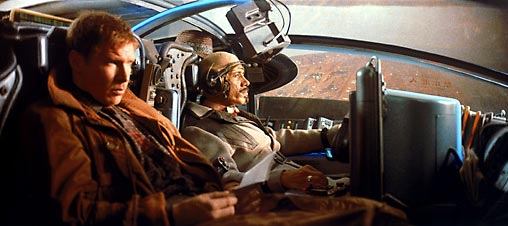 'The mission from the beginning," says Wallfisch, 'was finding the heart of the film…finding a musical analog to K's struggle with the idea of what defines humans versus highly developed replicants that are indistinguishable. What does that sound like? It was definitely a process of discovery. And then we arrived at the simplest possible theme"a four-note melody, which has a sort of symmetry to it. And as soon as we hit on that, it was like the doors opened to the rest of the score."
'The mission from the beginning," says Wallfisch, 'was finding the heart of the film…finding a musical analog to K's struggle with the idea of what defines humans versus highly developed replicants that are indistinguishable. What does that sound like? It was definitely a process of discovery. And then we arrived at the simplest possible theme"a four-note melody, which has a sort of symmetry to it. And as soon as we hit on that, it was like the doors opened to the rest of the score." In addition to the music by Zimmer and Wallfisch, cinephiles will notice echoes of Vangelis's 'Tears in the Rain" from the 'Blade Runner" soundtrack. The familiar notes form an aural bridge between the two films.
Villeneuve reflects, 'For me, -Blade Runner 2049' is a love letter to -Blade Runner,' and I know all of the artists who worked on this film were deeply inspired by its universe and by Ridley Scott's vision. Even people who don't know that universe will discover that while this is a science fiction movie, most of all, it's a very compelling human drama.
'The story is not focused on technology," the director concludes, 'but definitely on the human condition, and I think that's what makes it so powerful. I never want to say what people will take away from a movie, but what I can say is I hope people will enjoy it. I hope they will be moved by K's journey."
Blade Runner 2049
Release Date: October 5th, 2017
Trailer
Have You Seen This?
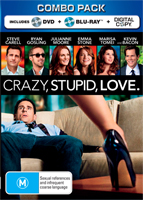
Crazy, Stupid, Love DVDs
Thanks to Warner Home Video here is your chance to win one of 6 x Crazy, Stupid, Love on dvd.
MORE
- Mission: Impossible Fallout
- Glenn Close The Wife
- Allison Chhorn Stanley's Mouth Interview
- Benicio Del Toro Sicario: Day of the Soldado
- Dame Judi Dench Tea With The Dames
- Sandra Bullock Ocean's 8
- Chris Pratt Jurassic World: Fallen Kingdom
- Claudia Sangiorgi Dalimore and Michelle Grace...
- Rachel McAdams Disobedience Interview
- Sebastián Lelio and Alessandro Nivola...
- Perri Cummings Trench Interview


